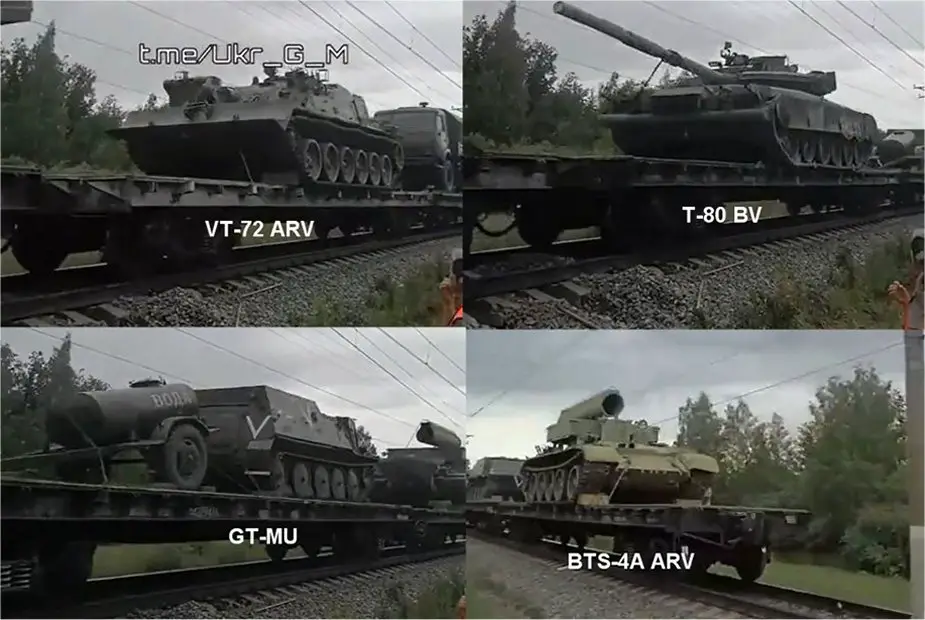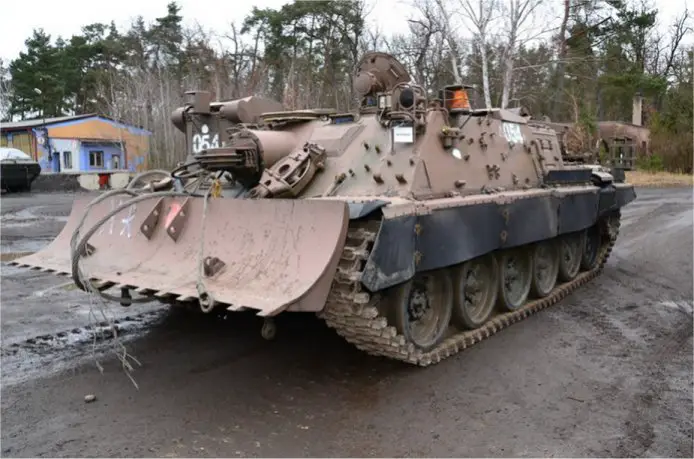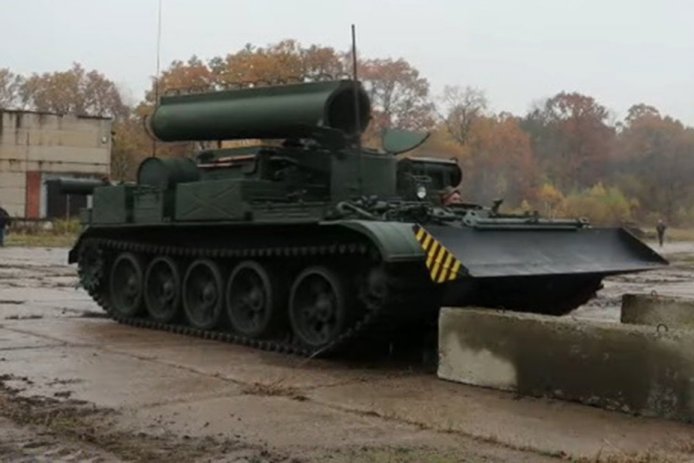- Army
- Conflicts in the world
- Israel - Iran conflict 2025
- Pakistan - India Conflict 2025
- Russia Ukraine War 2022
- Libya conflict day by day
- HAMAS - Israel War 2023
- Operation Serval in Mali French Army
- Sangaris operation Central African Republic
- Sangaris opération militaire République Centreafrique
- Ukraine - Russia conflict
- Syria conflict news
- Defence & Security Industry Technology
- Armies in the world
- Analysis Defense and Security Industry
- Conflicts in the world
- Navy
- Air
Rare Russian armored recovery vehicles spotted advancing towards Ukraine
On July 25, 2023, War Monitor tweeted about the sighting of a notable Russian equipment echelon advancing towards Ukraine, based on information from Russian sources. The echelon's composition was further elaborated by AFV Recognition, identifying some rare vehicles in the convoy. Along with a T-80BV main battle tank, these include a very rare VT-72 ARV (Armored Recovery Vehicle) based on the T-72 chassis, one very rare GT-MU light armored multipurpose transport vehicle and one BTS-4A ARV based on the T-44M.
Follow Army Recognition on Google News at this link

Along with a T-80BV main battle tank, the convoy includes a very rare VT-72 ARV based on the T-72 chassis, one very rare light armored GT-MU light and one BTS-4A ARV based on the T-44M (Picture source: Telegram)
Let's provide an overview of each of these vehicles:
The T-80BV is an upgraded version of the T-80B Main Battle Tank, which was first introduced into service with the Russian armed forces in 1985. At that time, several thousand T-80BV tanks were in storage. During the 2022 Russia-Ukraine conflict, a significant number of T-80BV tanks were deployed by the Russian armed forces for combat operations.
VT-72 Armored Recovery Vehicle (ARV)
The VT-72B is an armored engineering vehicle based on the T-72 tank chassis. It was manufactured in the late 1980s and early 1990s in the former Czechoslovakia. The primary role of the VT-72B is that of an Armored Recovery Vehicle (ARV), which means it is designed to recover immobilized or damaged vehicles from the battlefield. The VT-72B was equipped with a winch, a 19-ton crane, and a dozer blade, making it capable of handling recovery operations.

The VT-72 Armored Recovery Vehicle (Picture source: Euro Oldtimers)
Notably, the Czech Republic and Slovakia, successor states of Czechoslovakia, do not currently have VT-72Bs in their active inventory. However, the Czech army operates newer VT-72Ms. Despite this, VT-72B vehicles have been found on both sides of the Russia-Ukraine conflict. Both the Ukrainian and Russian forces have shown interest in these engineering vehicles, as they have experienced significant losses of tanks and armored vehicles during the prolonged conflict.
The significance of the VT-72B to the Ukrainian forces lies in its role in recovering damaged vehicles, including valuable assets like ex-German Leopard 2A6 tanks and other military equipment left behind on the battlefield. Reportedly, the Czech Republic, being a NATO member and a supporter of a free Ukraine, had supplied some VT-72Bs to Ukraine around 2014, shortly after Russia's invasion of Ukraine. On the other hand, it remains unclear how Russia acquired the VT-72Bs. The Russian army has a substantial number of recovery vehicles based on tank and fighting-vehicle chassis, but the presence of VT-72Bs in their inventory was not widely known until a video emerged showing one of these aging ARVs on this train.
GT-MU multi-purpose vehicle
The GT-MU (GAZ-73) is a versatile and armored tracked vehicle that has been in production in the Soviet Union since 1971. It served primarily as a prime mover, capable of towing various weapons and equipment, and it had amphibious capabilities, allowing it to traverse water obstacles. Despite its limited armor protection and armament, the GT-MU found application in various specialized roles, such as electronic warfare and surveying. Presently, ten surviving GT-MU vehicles can be found in different museums and institutions in Russia, where they serve as historical artifacts, reminding people of their significance in Soviet military history.

The GT-MU multi-purpose vehicle (Picture source: Wikimedia)
The GT-MU has a V8 115-horsepower liquid-cooled engine, providing a power-to-weight ratio of 26.24 hp/ton. With a loaded weight averaging around 5.8 tonnes, the vehicle could achieve speeds of approximately 55 km/h on roads and 5.5 km/h in the water, thanks to its amphibious capabilities. The fully armored body boasted an all-round thickness of 6 mm, offering some protection against light small arms fire. Equipped with a manual transmission with four forward gears and one reverse gear, the GT-MU utilized torsion bars for its suspension system and featured rubber-coated rollers with spring travel stops and telescopic hydraulic shock absorbers on the front and rear road wheels. The vehicle's interior included heaters in the fighting compartment, providing warmth to the crew and passengers, and a towing device on the back sheet of the bottom allowed it to tow trailers with a winch offering a pulling force of 3.922 Nm and a cable length of 100 meters. These technical specifications highlight the GT-MU's durability, adaptability, and functionality as a reliable tracked vehicle in various conditions.
BTS-4A Armored Recovery Vehicle (ARV)
The BTS-4 is an armored recovery vehicle developed by the Soviet Union based on the T-44M medium tank chassis. It was officially adopted by the USSR Ministry of Defense on November 11, 1967, and has since seen service in various countries, including Russia, Uganda, and Ukraine. The BTS-4's main purpose is to recover disabled tanks from the battlefield, particularly in hazardous conditions or under enemy fire.
In terms of dimensions, the BTS-4 measures 7170mm in length, 3270mm in width, and 3020mm in height. The wheelbase is 3800mm, and the track width is 2640mm, with a clearance of 460mm. Concerning its armor, the frontal hull offers 90mm of protection.
Powering the BTS-4 is a diesel V-54-E engine, generating 520 horsepower, allowing it to achieve a top speed of 50 km/h on highways. It has a cruising range of 450-500 km on the highway and possesses a specific power of 16.56 horsepower per ton and a specific ground pressure of 0.71 kg/cm². The vehicle can climb slopes with an inclination of up to thirty degrees and cross ditches of up to 2.85 meters. Moreover, it can ford water obstacles up to 1.3 meters (or 5 meters with an OPVT).

The BTS-4 Armored Recovery Vehicle (Picture source: Yandex)
The crew compartment of the BTS-4 is located at the front of the hull and accommodates two personnel responsible for operating the vehicle during recovery operations. At the rear of the hull, there is a cargo platform equipped with a powerful traction winch capable of pulling up to 30 tons of weight using a 200-meter-long cable. This winch provides the necessary pulling force to recover and tow damaged or immobilized tanks.
Additionally, the BTS-4 is armed with a 7.62mm RPK machine gun, which is equipped with 1000 rounds of ammunition for protection and firepower. Furthermore, the crew is armed with two AK Kalashnikov assault rifles for personal defense.
The BTS-4 has undergone various modifications over time, resulting in versions based on different tank chassis like the T-54, IT-1 missile tank, and T-55. These modifications allowed the BTS-4 to serve in various specialized roles and functions based on the specific tank chassis it was built upon.
One notable deployment of the BTS-4 was during the aftermath of the Chernobyl nuclear power plant accident in 1986. These ARVs were used in the cleanup and recovery efforts due to their ability to operate in hazardous and contaminated environments.
In more recent times, the BTS-4 has continued its service with modernization efforts. In 2021, upgraded BTS-4s were produced for the Ukrainian armed forces, incorporating components from the T-80 tank to enhance the vehicle's performance and capabilities.


























